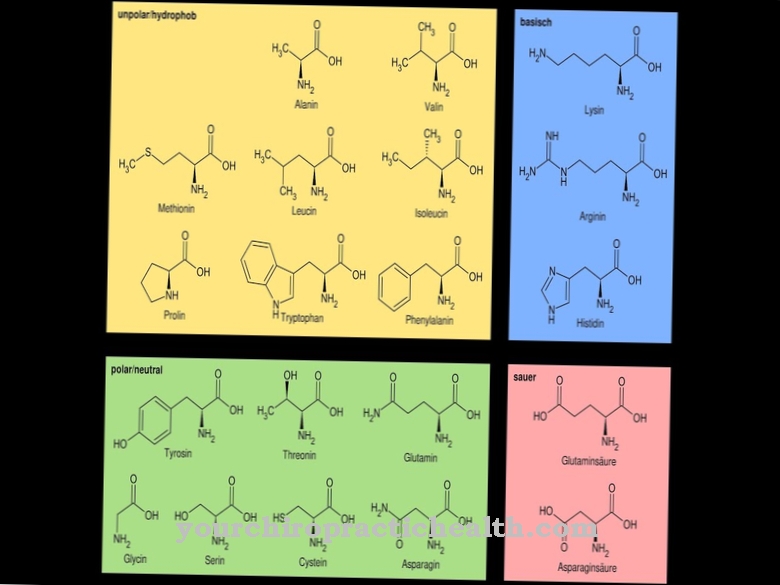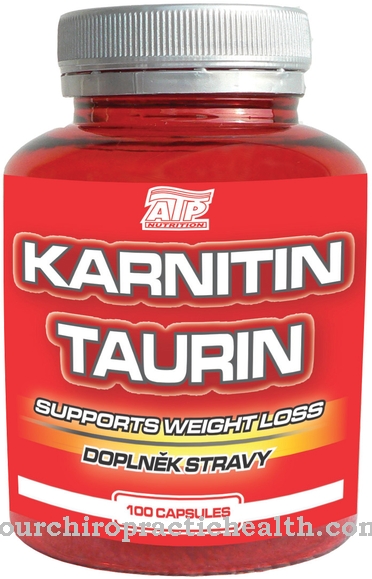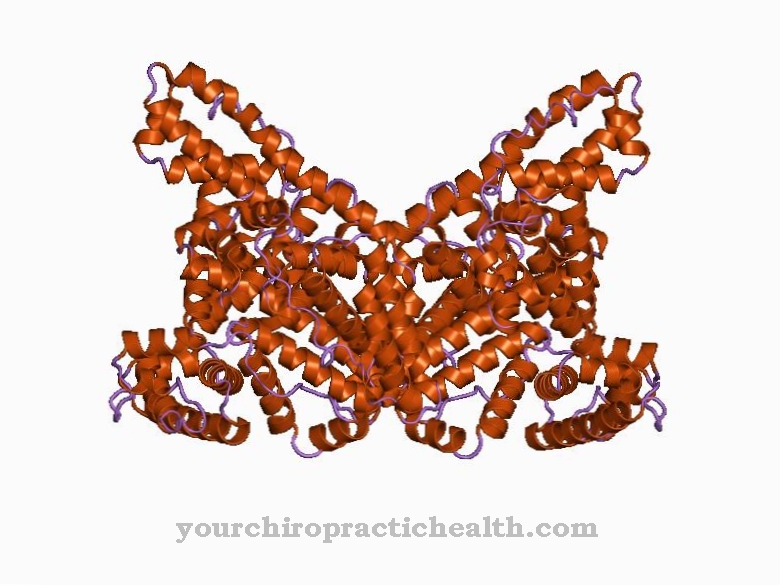Cobalamins represent chemical compounds that belong to the vitamin B12 group. They occur in all organisms. They are only synthesized by bacteria.
What are cobalamins?
Cobalamins are a group of chemical compounds with the same basic structure that belong to the vitamin B12 complex. It is a complex compound with cobalt as the central atom. They are considered to be the only known cobalt-containing natural substances.
The cobalt atom is surrounded by a total of six ligands. Four ligands each represent a nitrogen atom of a planar corrin ring system. The fifth nitrogen atom belongs to a 5,6-dimethylbenzimidazole ring, which is bonded to the corrin ring in a nucleotide manner. A sixth ligand is very easily bound and interchangeable. Only this interchangeable ligand characterizes the specific compound present. The actual vitamin B12 contains a cyano residue as the sixth ligand and is accordingly referred to as cyanocobalamin.
Other important cobalamins include aquacobalamin (vitamin B12a), hydroxycobalamin (vitamin B12b), nitritocobalamin (vitamin B12c), methylcobalamin (methyl-B12, MeCbl) and, as an extremely important coenzyme, adenosylcobalamin (coenzyme B12). All of these compounds also represent storage forms of vitamin B12. Cyanocobalmin is the only vitamin B12 that can be applied in medicine. It is immediately converted into coenzyme B12 in the body.
All storage forms of the active ingredient are absorbed through food. The vitamin B12 synthesized by bacteria in the large intestine cannot be used by humans because cobalamin absorption takes place in the small intestine.
Function, effect & tasks
Vitamin B12 fulfills important functions in blood formation, cell division and in the nervous system. In the organism it only takes part in two enzymatic reactions, but they are of central biological importance.
The enzyme N5-methyl-tetrahydrofolate-homocysteine-S-methyltransferase (methionine synthase) functions as a methyl group donor with the help of coenzyme B12. Methionine synthase reactivates the methyl group carrier S-adenosylmethionine (SAM) and remethylates homocysteine to methionine. If there is a deficiency or failure of vitamin B12, homocysteine accumulates in the blood. Increased homocysteine concentrations represent a risk factor for arteriosclerosis. Furthermore, the enzyme N5-methyl-THF also accumulates and thus ensures a secondary deficiency of THF (tetrahydrofolic acid).
THF supports the structure of the purine bases adenine and guanine as well as the pyrimidine base thymine. The nitrogen bases are involved in the construction of the nucleic acids DNA and RNA. If THF is missing, nucleic acid synthesis is disrupted. The second function of vitamin B12 is to support the enzyme methylmalonyl-CoA mutase. The methylmalonyl-CoA mutase breaks down odd-numbered fatty acids with the formation of propionyl-CoAs. Propionyl-CoAs is then introduced into the citric acid cycle. One metabolite in this process is methylmalonyl-CoA. If vitamin B12 is lacking, methylmalonyl-CoA accumulates, which can then lead to neurological symptoms.
Education, occurrence, properties & optimal values
Cobalamins cannot be produced in the plant, animal or human metabolism. Only a few bacteria are able to synthesize this active ingredient. This also includes human intestinal bacteria.
Since cobalamin synthesis takes place in the large intestine in humans, but vitamin B12 is absorbed in the small intestine with the help of the intrinsic factor, the cobalamin formed in the intestine cannot be used. Humans are dependent on supplies from food. At the same time, there is a biochemical process that allows vitamin B12 to be repeatedly transported back to the small intestine using bile acids, where it is reabsorbed. This means that once the reservoir in the liver is full, it will last for several years, even if there is no supply of vitamin B12. The liver can store 2,000 to 5,000 micrograms of cobalamin.
The minimum daily requirement for adults is around 3 micrograms. The need for children is lower and increases over time. Pregnant and breastfeeding women have a higher requirement, which is 3.5 to 4 micrograms per day. After 450 to 750 days, half of the existing cobalamin is used up. Important sources of cobalamin are the liver and innards of various farm animals, herring, beef, cheese, chicken eggs and tuna. Vitamin B12 is almost absent from plant foods. In the case of a vegetarian lifestyle, additional supplementation is required.
Diseases & Disorders
Due to the great importance of the biochemical reactions supported by cobalamines, a deficiency in vitamin B12 leads to serious health problems.
A deficiency can result on the one hand from a purely vegetarian diet and on the other hand from the loss of the intrinsic factor. The intrinsic factor is a glycoprotein that binds cobalamin in the small intestine and thus makes it available for reuse. This protein is produced in the parietal cells of the stomach. In gastric diseases with failure of the parietal cells, an intrinsic factor can no longer be formed. It is no longer possible to use the existing cobalamin again. The lack of vitamin B12 inhibits the methylation of homocysteine to methionine.
The homocysteine level in the blood increases and the risk of arteriosclerosis increases. At the same time, N5-methyl-tetrahydrofolate ((N5-methyl-THF) accumulates. THF is deficient. As a result, nucleic acid synthesis no longer functions properly. Processes with a high nucleic acid requirement such as blood formation are inhibited. The number of blood cells decreases, with the remaining erythrocytes enlarging as the hemoglobin replenishes.
The result is what is known as pernicious (malignant) anemia, which is not caused by iron deficiency. It can be treated with folic acid. The cobalamin deficiency, however, persists and still causes neurological complaints such as funicular myelosis or polyneuropathies via the disruption of methylmalonyl-CoA mutase through the accumulation of methylmalonic acid in the plasma.



.jpg)























